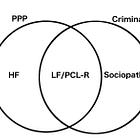Final Thoughts on the Persistent Predatory Personality
Wrapping up Dr. Mitchell's thesis
The final two chapters of Karen Mitchell’s thesis summarize her conclusions and offer some future directions for the research fields in question. I have already covered many of these points in previous articles, so will only focus on a few quotes that stand out for me. You can read all the other articles in this series below:
Mitchell’s PPP model posits that there is a single, overarching “dark” personality type that includes disorders and conceptualizations currently thought to be discrete phenomena. This includes psychopathy, Machiavellianism, and narcissism, which in this model are considered “partial conceptualizations” of the predatory personality.
The data appear to show that existing conceptualisations created within the personality and behavioural research communities to reflect people who actively violate social norms and harm and disadvantage others by conscious choice are subsets of one personality type.
This personality type is driven by a deep level of malevolence and with shared attributes including a drive to control, sadism, predation, manipulation, and self-focus.
I see the advantages of this model as twofold. First, redesigning the taxonomy of psychopathy adds an element of simplicity that the field has been lacking for decades. The phenomenon is still complex, but the academic understanding of it has become baroque with multiple competing and conflicting models, tests, and conceptualizations. The PPP model allows us to refocus on the actual problem: the existence of a specific “type” of human, one which humanity has always been aware of to some degree or another, but lacked the language to pin down.
By identifying and focusing on the key features seemingly shared by all individuals of this type, the specific traits that cause all the competing models to conflict with each other can be better understood as secondary, differentiating traits within the overall type. In other words, a smart predator with impulse control isn’t “less” psychopathic than his less intelligent, more impulsive counterpart. He is just a smart, self-controlled psychopath (or PPP).
Second, by clarifying the picture, mitigation becomes easier to achieve, because understanding replaces confusion—though the details of that will have to be worked out, e.g. in courts, prisons, hospitals, and in households, schools, and all sorts of groups and associations. Mitchell is apparently doing some work in this regard, so I look forward to following her updates:
I am working currently on a process that can be used to assess people for dark personality before they are employed by an organisation. It is very different to anything currently available because none of the research to date on dark personalities has provided such a comprehensive nuanced picture as the data I collected for my PhD. I will elaborate more on the process once I have finished it.
She recently appeared on Mark Vincente’s WTF podcast where she discussed her work in more detail, so if you’re interested, check out the video below:
Now, three quotations dealing with points that bear repeating:
One research participant practitioner explained that it was only in the relational dynamic between the person of DP and another whom they targeted and/or wished to intimidate and/or were angry with that the level of malevolence, the ‘calculated ferociousness,’ and the depth of potential to destroy was observed and/or sensed. They pointed out that most researchers are unlikely to experience this relational dynamic and so are not well placed to understand the depth of malevolence. They went on to say that even for those who collect extensive data from targets/victims of people of DP and who are better placed to understand the DP nature, there will be subtleties of exchange, elements of DP behaviour, that are missed by the researcher.
In other words, even researchers who spend their lives studying these people aren’t necessarily aware of how bad they really are. Everyone else is in an even worse position. Aside from direct personal experience, the only thing I can think of that would impart this understanding would be particularly well-written and well-acted dramatic pieces, like TV or film, depicting these dynamics realistically. There are some great on-screen representations of psychopathy, but I’m not aware that this has ever been done before on a high level. If there are any screenwriters reading, maybe you can try it out. I think it can be done.
The data collected for this study indicate that sexuality, for all adult people of DP, whether incarcerated or not, has substantial ‘darkness,’ far greater than the current literature (Brewer & Abell, 2015; Foster et al., 2006; Jonason et al., 2009) portrays.
The data in this study indicate that people of DP have complete boundarylessness regarding sexuality, and anyone, or anything, may potentially elicit their sexual attention. This may include, for example, both biological sexes, the full array of gender identities including transexual men and women and those who are nonbinary and gender fluid, their own children, others’ children, others’ partners, and animals. According to this study, expression of sexuality or sexual nuancing is personal to each, and its manifestation relates to opportunity, context, personal preference, and personal circumstances, but they all have exceptional proclivity for sexual and relational deviance.
It will be difficult, but I think this should be studied much more deeply than it has been. Is sexual boundarylessness a synecdoche for psychopathy, for instance? If we see hints of this trait, would we be justified in suspecting that such an individual may have a predatory personality? What would a random sampling of OnlyFans pornographers reveal, for instance?
Recent research has shown there is a greater likelihood that people of DP target their victims and that they have a finely tuned antennae for identifying vulnerabilities in others. … The findings from this study strongly indicate people of DP select those they target. Targets exhibit features of vulnerability such as a disability or illness, single parenthood, or childhood. They are often isolated or have limited support systems. They are generally ‘well meaning’ and are [easier] to manipulate and control.
If well-meaning people of the above descriptions were aware of this, maybe they would take steps to make themselves “untargetable.” I think this might be one of the most effective mitigation strategies, in fact. The more people are aware, the smaller the victim pool, and the better others would be able to protect the more vulnerable, like children.
On this note, I’ll close out this series with a quotation from one of the participants:
If we don’t contain them, it will be to our detriment. Sadly, I feel we are losing the battle despite outnumbering them twenty to one. (Category 4iii)













Your closing paragraphs struck a chill in me. The sense of community has been seriously eroded, at least in modern Western societies. From my own experience, and the stories told to me by my parents and grandparents, the decline in communities has been steady and worsening for at least fifty years. The modern sense of community is artificial and propped up almost entirely by local government, HOAs, and other organizations that are poor substitutes for natural human communities. It seems to create an environment that not only leaves lonely and vulnerable people easy targets for predators, but even creates the loneliness and vulnerability in the first place. Even worse, all those organizations and social services seem to attract the dark personalities in search of victims.
I live in a fairly small town with a low crime rate. It's far, far worse in the cities. There's a guy named Chase Hughes who has a Youtube channel that covers various psychological manipulation phenomena. He pointed out that the normal psychology of the modern city is fundamentally psychopathic.
I believe we're in the late stage of a full societal collapse, and it might be exactly what is needed to rebuild a healthy society.
Thank you so very much for all your work in diving so deeply into the darkness.
War shows that ordinary people are capable of tremendous cruelty and sadism if their leaders can successfully dehumanize The Other in the people's eyes.
I sometimes wonder if a psychopath is just a person who dehumanizes _everyone_ else.